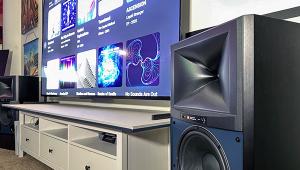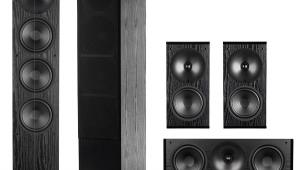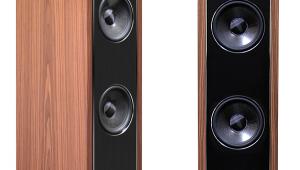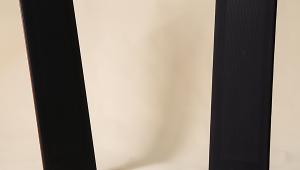Magnepan MMG Speaker System Measurements
All the measurements presented here were taken with the non-removable grilles in place. The nominal impedances were determined from the measured impedance curves (not shown).
All figures: Violet curve: pseudo-anechoic response on the tweeter axis, averaged across a 30° horizontal window, combined with nearfield responses of the woofers and port. All measurements taken at 1 meter.
Magnepan MMG W
Minimum impedance: 6Ω across the full range
Nominal impedance: 6Ω
Cabinet tuning: N/A
Effective bass extension (-10dB): 104Hz relative to the level at 1.0kHz (see text)
Sensitivity: 81dB/2.83V/m
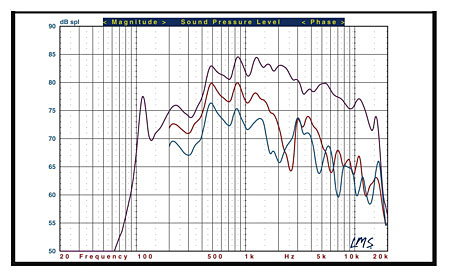
Fig. 1: MMG W, pseudo-anechoic response, off-center in the horizontal plane, at 45° (red) and 60° (blue).
The overall response of the MMG W is shown above. Before you go into shock, there are some very important things to realize about measuring a dipole speaker such as this.
Our measurements cannot take into account the contribution of the speaker's rear radiation, which is a major factor in any real room. In particular, the bass and midbass rolloff from about 150Hz to 500Hz will be affected by the room. The on-wall mounting recommended by Magnepan for these speakers should help balance out the dip in this region. For this reason, the dip may well be a deliberate part of the MMG W's design. However, Wes' comment that the midbass sometimes sounded a bit lean suggests that perhaps wall placement did not entirely compensate for this dip, at least not in his room.
We can draw a few reasonable conclusions about the MMG W from our measurements. First, unlike most speakers, its impedance is totally uniform at 6Ω (give or take a fraction of an ohm) across its full frequency range. The impedance phase angle is also almost entirely resistive. This speaker should be very easy to drive, though its low sensitivity (see discussion below) is somewhat demanding. (The same is true of the MMG C, also discussed below.)
Second, no room placement or room effect can compensate for the severe low-frequency rolloff below about 120Hz, which is close to Magnepan's claimed response down to 100Hz. As Wes emphasizes in his review, you need to add a subwoofer to achieve the bass required from a home theater system.
Third, the high-frequency response rolls off rather rapidly as you move off axis, accompanied by uneven peaks and dips at varying angles due to comb filtering. In fact, small adjustments in the angle of the speaker may result in significant audible changes in the response.
Finally, the MMG W is very insensitive. If you expect to drive it to high levels in any reasonably sized room, you need a goodly amount of power. A clean 100 watts per channel is not an unrealistic minimum, unless your room is very small and/or your preferred playback level is modest.

Fig. 2: MMG W, pseudo-anechoic response at 15° above (red) and 15° below (blue) the tweeter axis.
The vertical response of the MMG W indicates a more potent, but less smooth, high-frequency output as you move up or down from the center of the panel (where our on-axis measurements were taken). Your vertical listening height will also be important in what you hear from these speakers.
I recommend experimenting with positioning the MMG Ws before screwing them permanently into a specific spot on the wall or the side of that armoire.
MMG C
Minimum impedance: 6Ω across the full range
Nominal impedance: 6Ω
Cabinet tuning: N/A
Effective bass extension (-10dB): 164Hz relative to the level at 190Hz
Sensitivity: 83dB/2.83V/m
As with the MMG W, the MMG C has a constant, resistive impedance and should be an easy load to drive. But it's nearly as insensitive as the MMG W, so you'll need plenty of power to drive it to reasonable home-theater levels.

Fig. 3: MMG C, pseudo-anechoic response, off-center in the horizontal plane, at 45° (red) and 60° (blue) on the woofer side.
The MMG C's averaged response (violet curve) is smoother than that of the MMG W, and it retains a reasonable smoothness off axis without serious suckouts apart from a generally reduced response above 2kHz. The lack of significant high-frequency peaks likely contributed to the smooth dialog Wes reported. However, the bass rolls off severely below 200Hz, which may well have made a larger contribution to the lean midbass than the response of the MMG Ws.

Fig. 4: MMG C, pseudo-anechoic response at 15° above (red) and 15° below (blue) the tweeter axis.
The MMG C's vertical response was strongly affected by small off-axis differences. Angle it toward the listening position if at all possible. Thomas Norton




